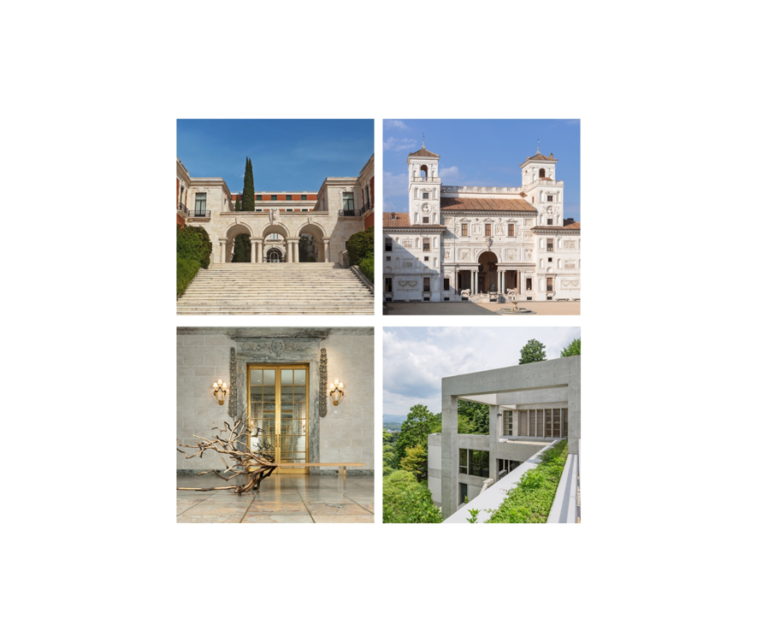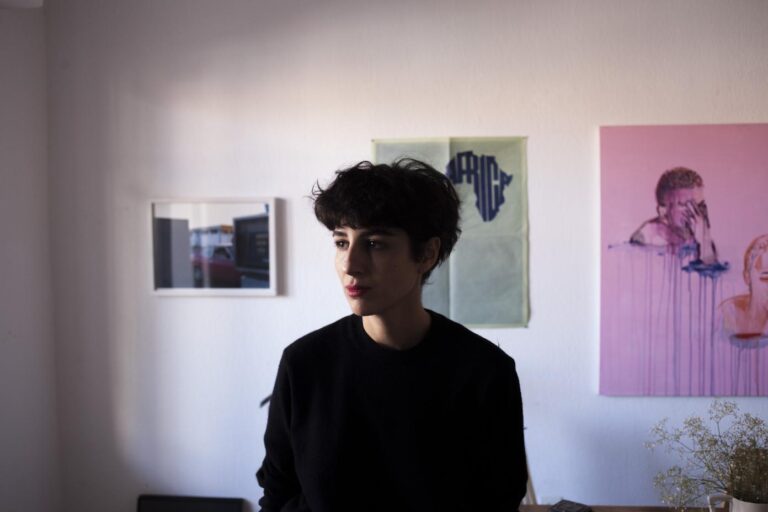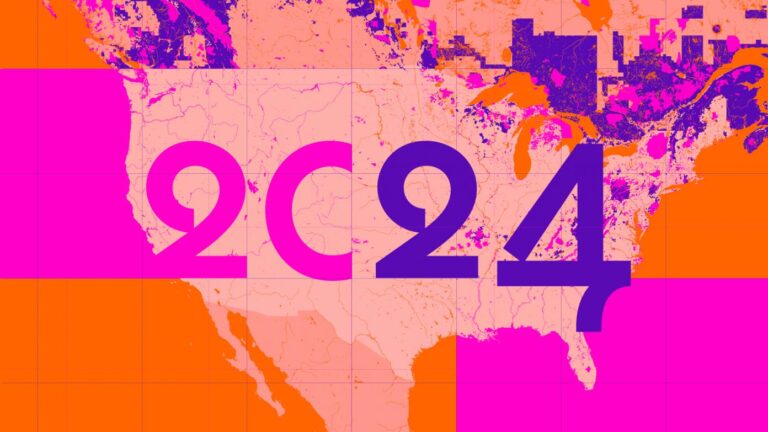
Grantees 2021: Etant Donnés Contemporary Art
Art & Design
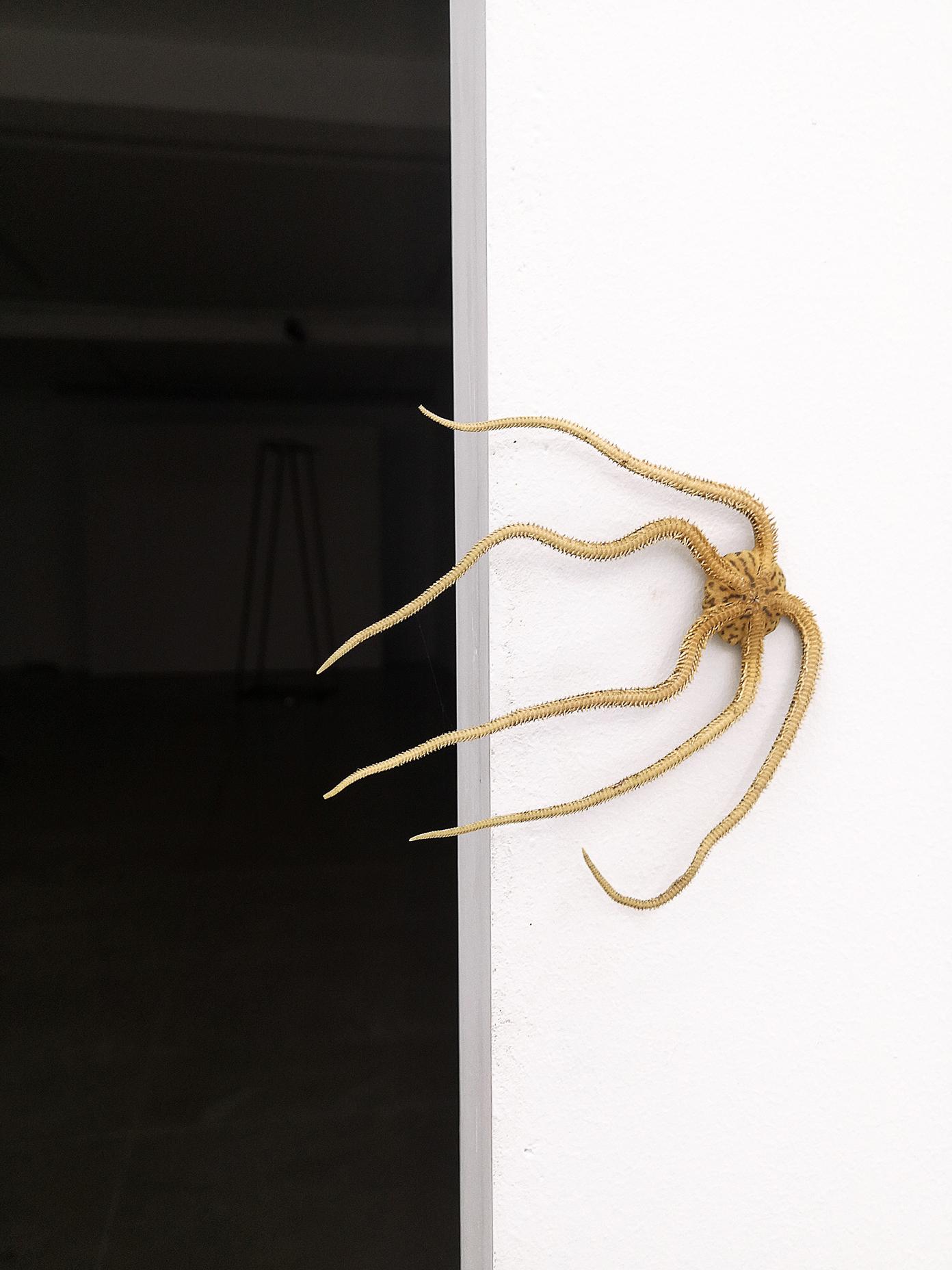
Alex Ayed
We are pleased to announce the 14 grantees selected this year by the Étant Donnés jury, with a total grant allocation of $195,000.
Grants for Artistic Projects
- Orisons
Site-specific commission by Marguerite Humeau
Black Cube, A Nomadic Art Museum
June 2022
Curated by Cortney L. Stell
French artist Marguerite Humeau’s Orisons is an unprecedented large-scale, newly commissioned earthwork situated in rural Colorado. Measuring up to 10 acres in diameter, the earthwork is reminiscent of a gigantic crop circle and is visible from land or sky. The work itself consists of a repurposed center-pivot irrigation system that mechanically spins, collecting and distributing rainwater in a circular pattern to stimulate the growth of native, medicinal plants. Planted according to the changing seasons, Orisons visually transforms over time, inviting visitors to experience colorful blossoms in the spring and withering shades of brown in the winter.
Through a hypothetical and resonant narrative, Humeau’s earthwork surfaces a vital question—what happens when our aquifers dry up? In this work, the irrigation system is akin to an otherworldly being on a cosmic quest to produce rainfall, healing the soil and reviving vegetation, before becoming extinct. Using partially harvested rainwater as a sustainable water source, the center-pivot irrigation system is programmed to disperse water at an environmentally safe pressure rate on a plot of land that contains planted seeds. In this way, the earthwork explores the relationship between land and sky. Orisons connects a constellation of subjects, including innovative regenerative farming practices, ancient plant medicine and contemporary mythologies, which altogether highlight the interconnections between humankind and the environment.
- 2021 Triennale: Soft Water Hard Stone
Group show including Alex Ayed and Gaëlle Choisne
New Museum, NYC
October 26, 2021 – January 23, 2022
Curated by Margot Norton and Jamillah James
The title of the 2021 Triennial, “Soft Water Hard Stone” is taken from a Brazilian proverb: Água mole em pedra dura, tanto bate até que fura (“soft water on hard stone hits until it bores a hole”). The proverb can be said to have two meanings: that if one persists long enough, the desired effect can eventually be achieved; and that time can destroy even the most perceptibly solid materials. The title speaks to ideas of resilience and perseverance as it evokes the impact that an insistent yet discrete gesture can have over time. It also provides a metaphor for resistance, as water—a transparent, fluid, and often underestimated material that makes up the majority of both our bodies and the planet itself—is capable of eventually dissolving stone, an inflexible substance associated with monumentality, yet also composed of tiny particles that can collapse under pressure. In this moment of profound change, where structures that we once thought to be stable are revealed to be precarious, not working, or on the verge of collapse, the 2021 Triennial acknowledges artists and collectives reimagining traditional models, materials, and techniques beyond established paradigms. Their works exalt states of transformation, calling attention to the malleability of structures, permeable walls, porous and unstable surfaces, and the fluid and adaptable potential of both technological and organic media. The works included in the exhibition recall a sensibility that is simultaneously prehistoric and post-apocalyptic, looking back toward overlooked artistic traditions and technological building blocks, while at the same time looking forward toward the immaterial and the transitory, and creative modes not yet imagined.
French-Tunisian artist Alex Ayed will present a new body of sculptural works made specifically for the 2021 New Museum Triennial. Inspired by the exhibition’s title and theme, Ayed will present works that respond to the architecture of the New Museum and experiment with material capabilities as their form changes throughout the duration of the show. The materials Ayed commonly uses, which range from found objects that he sources along his journeys to sand and Tunisian olive oil soap, each come with rich histories yet are not commonly used in a traditional art context, and point toward possibilities beyond those typically housed within the walls of the institution. As borders have been shut and travel has been limited due to the global pandemic, Ayed has turned much of his attention to researching modes of sea travel. The works he will present in the 2021 Triennial will draw from this research and from the winds that both make nautical travel unpredictable and cause boats to move faster in order to reach their destination. For Ayed, this metaphor of the wind speaks to our current moment of instability, which may cause chaos yet pushes us to realize necessary change.
The work of French-Haitian artist Gaëlle Choisne addresses many of the disorders that plague our society, from the climate crisis and the exploitation of natural resources to the structural remains of colonialism. For the 2021 New Museum Triennial, Choisne will develop a new video and sculptural installation responding to the exhibition’s title and theme. As she often draws from Caribbean and European literary sources, her new work is inspired by Roland Barthes’ 1977 text “A Lover’s Discourse,” as well as her own ongoing research on systemic racism, violence, and surveillance. The installation incorporates found objects, some of which have been gathered by the artist for many years, as well as materials such as Plexiglas sheets often used for hygienic or safety purposes, and metallic objects made by the artist in a facility that manufactures weapons in the South of France. Choisne’s project will also incorporate architectural elements using mycelium and draws connections between a fungus-like bacteria that can grow in the stomach of dogs and elicit violent behavior in the animal and propagating police brutality. In this work, Choisne expands from Roland Barthes’ quote “I am the one who waits,” to add: “I am the one who waits, for a new life, equal for everybody.”
- Solo Show by Iván Argote
Image of Iván Argote’s Artpace Summer 2021 International Artist-in-Residence exhibition titled All Here Together. Photo by Beth Devillier. Originally commissioned and produced by Artpace San Antonio.
Artpace San Antonio
July 15 – September 15, 2021
Curated by Pilar Tompkins Rivas
Born in Bogotá, Colombia in 1983, Argote graduated from École Nationale Supérieure des Beaux-Arts de Paris in 2009 and has remained living and working in Paris since. His work explores the relationship between history, politics, and the construction of our own subjectivities. His films, sculptures, collages, and public space installations attempt to generate questions about how we relate to others, to the state, to heritage, and to traditions. His works are critiques, sometimes anti-establishment, and deal with the idea of bringing affects to politics and politics to affects with a strong and tender tone. He makes political and sociological critiques and proposals using affection, emotions, and humor as subversive tools with which he tries to generate spaces of dialogue away from polarization and confrontational rhetoric.
Argote’s artistic career has gained significant momentum over the last several years, though his exhibition history in the United States remains limited. In a time when the United States is grappling with its own identity, history, and role in the global community, highlighted with the unprecedented insurrection of the US Capitol in January 2021, it is a pertinent time for Argote to explore the themes of his practice within the context and physical location of the United States, especially in the South, where these political and societal tensions often emerge most clearly.
During his stay, Argote will be provided with a studio space and the support and resources he needs to fully focus on the work at hand, respond to his environment, and execute the project in whichever form he sees fit. Once the work is produced, his installation will be on display at Artpace, addmission-free for the public to see, seven days a week for two months. The exhibition will also be accessible virtually through high-quality 3D scans that produce dynamic 3D tours of the space.
- Impossible Mediations: Silence and Oblivion are Information
Solo show by Clémence de Montgolfier
Los Angeles Contemporary Archive
End of 2021 – April 2022
Clémence de Montgolfier, Le passé est un autre pays (The Past is Another Country), HD video (screenshot), 34 mn 24 sec, 2021. Production : La Fondation des artistes, Paris, France.
Curated by Hailey Loman
The project will take the form of a solo exhibition and onsite research by French artist Clémence de Montgolfier at the Los Angeles-based nonprofit Los Angeles Contemporary Archive, an art archive, library, and exhibition platform that collects underexposed artistic modes of expression happening in our current moment, challenging the notion of archive and art space. De Montgolfier, a doctorate in Media Studies from the Sorbonne University in Paris whose work investigates the politics of public speaking, representation, and the mediations of speech, started working on this artistic research in 2020. Her project, entitled Les Méditations impossibles (Impossible Mediations), originally supported by the Artists’ Foundation (Paris), resulted in the production of a series of artworks examining conflict resolution, the government of the self and others (in the sense of Michel Foucault’s eponymous book) and the concepts of the production of “truth” and “reconciliation.” In this project, the artist has chosen to investigate, almost as one would a case study, “Truth and Reconciliation Commissions,” a model of transitional justice commissions that have been organized in countries in democratic transition since the 1980s. Their aim is to publicly acknowledge and uncover human rights violations committed by authoritarian groups or regimes and to propose forms of reparation.
This multifaceted project is based on research, meetings, and filmed interviews conducted with former commissioners and staff who have served on truth and reconciliation commissions (TRCs) around the world, as well as with experts who have testified in these commissions or studied them. The artist will particularly look at the history of the South African Commission, the more recent case of the Canadian Truth commission on residential schools (2010-2015), and the ongoing independent commission on sexual abuse in the Catholic Church (2018-2021, Paris).
- Other Repercussions
Group show featuring Tarek Atoui, Marcos Avila Forero, Angelica Mesiti, Laure Prouvost, and Cyprien Gaillard
California Institute of the Arts – Wattis Institute
September 2022
Marcos Ávila Forero “Atrato” (2014) HD video, 13’52” Courtesy of the artist
Curated by Anthony Huberman
Other Repercussions proposes “the percussive” as an aesthetic and political concept. While percussive instruments have remained at the center of most musical traditions around the world for thousands of years, this exhibition moves beyond the framework of music and outlines a broader “percussive field” as a model for art and politics.
Central to the exhibition will be works by French artists or artists living in France, each of which speaks to the exhibition’s central themes in powerful ways. Tarek Atoui, who has a longstanding practice related to sound’s physical impact on bodies and surfaces, conceives a new piece for the exhibition. Shot with Indigenous people in the Colombian Amazon, Paris-based artist Marcos Avila Forero’s Atratro (2014) captures bodies in a river, communicating with each other, and with the river itself, by slapping the water in coordinated rhythms. Paris-based artist Angelica Mesiti’s film The Calling (2013-2014) explores different rural communities whose inhabitants communicate via whistling. Laure Provost’s early single channel video works, though they don’t depict anything percussive or musical, turn sounds, images, and words into a percussive sequence of quick edits and sudden stop-and-starts. Cyprien Gaillard’s early apocalyptic video Desniansky Raion (2008) combines the clash between two groups of hooligans and the demolition of an apartment tower block to create forceful violence of different types.
With these and other works, Other Repercussions asks what the percussive can do: what does its abstraction mobilize and what does it threaten? What is a percussive gesture, a percussive shape, a percussive image, a percussive story? What is a percussive form of being together? Artists and writers have long used a musical vocabulary to talk about art and politics, and, borrowing from the writer and poet Fred Moten, the exhibition asks whether the percussive can be a way to assemble—to become a political model where diverging perspectives don’t agree, disagree, or even work towards a consensus but where they gather, co-exist, listen to each other, make something with each other, and mutually adapt to a context as it evolves, like an ensemble.
- Southwind
Solo show by Maxime Berthou
Louisiana Museum Foundation – New Orleans Jazz Museum
October 2021 (Prospekt New Orleans Triennial)
Curated by Amy Mackie
Artists Maxime Berthou (France) and Mark Požlep (Slovenia) embarked on a practice-based research journey on the Mississippi River from September 2 to October 20, 2019. Their means of transportation was a hand-built 20-foot (6-meter) steam-powered paddle boat named Thumpa. Their goal was to research and experience contemporary American life along this mythical river. Following the methodology and chronology of a research-action project, Southwind is an investigation into personal experience, transcription, and disproportion through the production mechanisms of an artistic project. Endurance related to traveling on this specific vessel allowed the artists to interact with a diversity of social environments and realities along the 2,320-mile (3,730 km) long river. Though their role was primarily to document daily life along this infamous stretch of America, their personal interactions positioned them as active co-creators. The project was documented in the form of video, writing, photographs, sound recordings, and drawings. The artistic outputs are a film that includes interviews and portraits of the people and locals they encountered along the river, an artist book in the format of a journal, and an installation that includes drawings, photographs, and other ephemera. They continue to engage in educational workshops and presentations about the project in Europe and will conduct a similar educational initiative in the US.
The New Orleans Jazz Museum will present an outdoor screening of the film Southwind in October 2021 during the international triennial, P.5 (Prospect New Orleans). The film will be presented in the form of a “Cinema Concert.” Live narration and voiceovers for the film will be performed by performance artist David Freeman, followed by live music by New Orleans jazz musicians. Screenings will include two nights of live performances. Several installations that include evidence and further documentation of this project will be presented inside the museum and will be on view throughout the triennial. The film will additionally be available online. Amy Mackie is the curator of the presentation of Southwind at the New Orleans Jazz Museum, and PARSE NOLA, her nonprofit residency and art program based in New Orleans is serving as a collaborator and producer of this project.
- The Language in Common
Group show including Julien Creuzet
Wesleyan University
September 14 – December 12, 2021
Curated by Benjamin Chaffee
The Language in Common, a group exhibition planned for September 14 – December 12, 2021 in the Ezra and Cecile Zilkha Gallery at the Center for the Arts will feature the work of five artists working at the intersection of visual art, poetry, and performance, including Julien Creuzet (b.1986, France), Cecilia Vicuña (b.1948, Chile), Tanya Lukin Linklater (b.1976, Alutiiq), Jasper Marsalis (b.1995, US), and Alice Notley (b.1945, US). Creuzet’s newly commissioned installation installation works are envisioned as a central element of this exhibition.
The Language in Common presents artistic practices that move in the space between poetry, visual art, and performance. Through an exhibition, public programming, and a chapbook publication series, the project aims towards what the poet Alice Notley calls, “the language that holds all being together.” There is language that precedes us. Poetry that precedes us. Art that precedes us. Moving beyond the spectacle of their origination this project seeks to allow memory as a creative act in the process of making experience common, of making space for a new imaginary.
Julien Creuzet’s work will create, with Cecilia Vicuña’s, a dynamic comparison sharing a focus on the injustices of Neoliberalism. The exhibition will include Creuzet’s poetry, sculpture, wall-based photographic murals and video, as counterpoints to Vicuña’s exploration of the Andean quipu. While engaging similar ideas of resistance to hegemonic political narratives, Creuzet and Vicuña work from very different diasporic positions, and Creuzet digs deeper in the nature of those very positions with this conceptualization of “geolocalization,” and the different impact of Neoliberalism on individuals depending on social position, geography, history, race, gender… He raises the idea that we are global subjects, though hyperlocal in expression, with the influence of Edouard Glissant’s Le Tout Monde (Whole World, or One World).
- Breaking Water
Contemporary Arts Center (CAC) (Cincinnati, OH) for Breaking Water, a group show including works by Cecilia Bengolea, Paul Maheke, Josèfa Ntjam, Marcos Avila Forero, and Saodat Ismailova.
May 6, 2022 – August 15, 2022
Installation view: Paul Maheke (b. 1985, Brive-la-Gaillarde, France; lives and works in London, UK), Le Fil d’Alerte, Fondation d’entreprise Ricard, Paris, September 10, 2019 – October 26, 2019. Courtesy of the artist and Galerie Sultana, Paris. Photo: Aurélien Mole.”
Curated by Amara Antilla and Clelia Coussonnet
Breaking Water is a group exhibition bringing together works in installation, video, photography, painting, sculpture, and performance that offer a range of approaches to the subject of water, liquidity, and feminism. The exhibition will debut four new commissions by Paul Maheke, Josèfa Ntjam, Claudia Peña Salinas, and a collaborative work by Calista Lyon and Carmen Winant alongside new and existing work by an international group of artists whose work explores themes of fluidity, connectivity, and resistance, and addresses timely concerns including water rights, climate change, and the effects of natural disasters. Co-curated by CAC Senior Curator Amara Antilla and independent curator and writer Clelia Coussonnet, Breaking Water will be on view at the CAC from May 6 through August 15, 2022. The exhibition will be accompanied by a parallel film screening program that extends the exhibition’s central themes and a hybrid catalogue.
Full artist list:
- Martha Atienza (b. 1981, Bantayan, Philippines; lives and works in Bantayan, Philippines)
- Marcos Ávila Forero (b. 1983, Paris, France; lives and works in Paris, France)
- Cecilia Bengolea (b. 1979, Buenos Aires, Argentina; lives and works in Paris, France)
- Andrea Carlson (b. 1979, Grand Portage Ojibwe, USA; lives and works in Chicago, IL)
- Carolina Caycedo (b. 1978, London, UK; lives and works in Los Angeles, CA)
- Jes Fan (b. 1990, Ontario, Canada; lives and works in New York, NY)
- Cleo Fariselli (b. 1982, Cesenatico, Italy; lives and works in Turin, Italy)
- Saodat Ismailova (b. 1981, Tashkent, Uzbekistan; lives and works in Tashkent, Uzbekistan and Paris, France)
- Jaana Laakkonen (b. 1985, Joensuu, Finland; lives and works in Helsinki, Finland)
- Calista Lyon (b. 1986, Nagambie, Australia; lives and works in Charlottesville, VA) and Carmen Winant (b. 1983, San Francisco, CA; lives and works in Columbus, OH)
- Paul Maheke (b. 1985, Brive-la-Gaillarde, France; lives and works in London, UK)
- Josèfa Ntjam (b. 1992, Metz, France; lives and works in Saint-Étienne, France)
- Claudia Peña Salinas (b. 1975, Montemorelos, Nuevo León, Mexico; lives and works in Brooklyn, NY)
- Vian Sora (b. 1976, Baghdad, Iraq; lives and works in Louisville, KY)
- Nomeda and Gediminas Urbonas (collaborators since 1997; live and work in Vilnius, Lithuania and Cambridge, MA)
Paul Maheke (b. 1985, Brive-la-Gaillarde, France; lives and works in London, UK), Seeking After the Fully Grown Dancer *deep within*, 2016-2018. Documentation of performance at Blackwood Gallery, Toronto. Courtesy of the artist and Galerie Sultana, Paris. Photo: Henry Chan.
Credits: Installation view: Paul Maheke (b. 1985, Brive-la-Gaillarde, France; lives and works in London, UK), Le Fil d’Alerte, Fondation d’entreprise Ricard, Paris, September 10, 2019 – October 26, 2019. Courtesy of the artist and Galerie Sultana, Paris. Photo: Aurélien Mole.
- Who Speaks for the Oceans?
Group show including Marguerite Humeau, Josèfa Ntjam, Jacques Cousteau, Chris Marker
Mishkin Gallery (Baruch College, CUNY), New York City
Spring 2022
Curated by Alaina Claire Feldman and David Gruber
Whale songs are like canaries in a coalmine. They are barometers of the health of our oceans. As we approach a crucial moment concerning the condition of our planet, listening to their vocalizations can bring us closer to understanding and encouraging action towards stewardship of the oceans. Engaging contemporary artworks, cultural artifacts, historical ephemera, and speculative futures, Who Speaks for the Oceans? will consider humanity’s desire to experience and communicate with the non-terrestrial, specifically focusing on an epistemological and historical analysis of what we think we know about life in the ocean. Many of these ideas have been informed by colonial, racialized, gendered, and terra-centric conventions alongside the production of nature, which will be exposed and critiqued through the multiple perspectives of an international group of artists.
The history of oceanography has a deep connection to French culture, as the country has over 4,500km of coastline. As early as the 1880s, France hosted its first public exhibition exclusively dedicated to the previously unknown wonders under the ocean, titled L’Exposition Sous-Marine du Travailleur et du Talisman and held at National Museum of Natural History in Paris. The exhibition was extremely popular and kickstarted the underwater craze which has since been a strong French tradition. The show aligns itself with this history and tradition by inviting a group of international artists, including four French artists: Marguerite Humeau, Josèfa Ntjam, Jacques Cousteau, and Chris Marker, to question what we think we know about life under the sea and contemporary human-animal relationships.
Using the so called “whale song” as a primary example of the West’s oceanic desires to externalize, taxonomize, and dominate nature and other species, artwork and materials in this exhibition will also consider how technology, assumed to be indexical and scientific, has informed imaginary and fantastical perspectives of non-terrestrial worlds. In order to understand and appreciate an entanglement with animals and the oceanic environment, we need to listen to their calls outside of patterns of consumption in order to develop meaningful relationships with them.
Who Speaks for the Ocean? will take place at Mishkin Gallery at Baruch College, City University of New York and is curated by David Gruber, professor, marine biologist, and National Geographic Explorer and Alaina Claire Feldman, professor and Director/Curator of the Mishkin Gallery. The gallery is located in central Manhattan and is dedicated to interdisciplinary education and the advancement of art appreciation through new lenses. New commissions will be displayed alongside existing works and historical objects. A series of student-initiated public programs including workshops, listening sessions and artist talks will be developed in parallel to the exhibition. Who Speaks for the Oceans? engagement with local and international artists and a drive to engage students will create affective empathy for the fragility of our environment and the creative ways in which listening to one another can lead to productive solutions.
- Light’s New Measure by Etel Adnan
Guggenheim Museum, NYC
October 2021 – January 2022
Credits: Journey to Mount Tamalpais (detail; 2008), Etel Adnan. Private collection Courtesy Galerie Claude Lemand, Paris. Photo credit: Etel Adnan
Curated by Katherine Brinson
Opening October 22, 2021 and running through January 10, 2022, the Solomon R. Guggenheim Museum will present Light’s New Measure, a solo show dedicated to the works of Etel Adnan, a famous Lebanese painter based in France. Light’s New Measure will run alongside an exhibition dedicated to the works of Wassily Kandinsky. Operating much in the same way as the landmark R.H. Quaytman: + x, Chapter 34 and Hilma af Klint: Paintings for the Future exhibitions, Adnan and Kandinsky’s work will mirror each other across the decades in these dual presentations, encouraging audiences to draw connections between these revolutionary, modernist artists.
Etel Adnan’s show will occupy the first three ramps of the Guggenheim’s iconic rotunda with approximately 90 works of art, followed by the Kandinsky exhibition above. Adnan’s work will be the first of three contemporary artists to be presented alongside the Kandinsky exhibition, which will run until August 2022.
This focused exhibition will survey Adnan’s influential practice over the course of seven decades, encompassing paintings, tapestries, films, and her “leporellos”: accordion-fold paper books that straddle her linguistic and pictorial registers. The first solo presentation of an Arab American artist to be staged in the Guggenheim Museum’s rotunda, the exhibition will elucidate the artist’s longstanding fascination with the work of Vasily Kandinsky and the architecture of Frank Lloyd Wright. This exhibition is organized by Katherine Brinson, Daskalopoulos Curator, Contemporary Art, and Lauren Hinkson, Associate Curator, Collections.
Born almost a century ago in Lebanon, Etel Adnan (b. 1925, Beirut) has forged a creative language of singular power and lyricism. Her expansive career spans the mid-century to the present day and across multiple languages, continents, and disciplines. While Adnan’s poetry, fiction, and journalism has offered searing political responses to events such as the Vietnam War (1961-75) and Lebanese Civil War (1975- 90), her visual art is intensely engaged with the transcendent themes of nature and memory. Characteristically modest in size, her paintings are created in a single sitting, their intense colors applied in decisive strokes with a palette knife. Obsessively iterating on recurring themes such as a mountain landscape, the rising and setting sun, and the ocean, they distill a sense of both the fleeting moment and the eternal.
Curatorial Fellowship
- Telepathies by Ana Iwataki
Independent Curator
June 2022
In collaboration with French curator Marion Vasseur Raluy, American artist Alexandra Grant, and acclaimed writer Hélène Cixous, independent curator and current University of Southern California doctoral student Ana Iwataki will undertake on-site research for a project titled Telepathies. Following a year of remote collaboration, research, and preparatory work with contacts and partner institutions in France and the US, the four will meet in Paris to conduct research in Hélène Cixous’s archives at the Bibliothèque Nationale de France.
Telepathies is a project emerging from a long history of recurring dialogic, transnational, and translational collaborations between the contributors, who will also use the month in Paris to record their conversations and conduct studio visits with other artists working in relational modes. The work will be a testament to Iwataki’s extensive and ongoing exploration of translation, fluidity, the porosity of boundaries, and the potential of mutual influence. It will be grounded in Cixous’s writing and will bring other artists into dialogue with Grant’s art. The vision for Telephathies is a work grounded in archetypes, centered on two objects—a tarot deck and a book—that will embody a cosmology of deep listening and relation to the other, enabling live performance, and participatory elements on both sides of the Atlantic. At the crossroad of various kinds of knowledge, Telepathies will forge connections and collapse the space separating the academy, art institutions and activist spaces. The team plans to partner with institutions in both Paris and Los Angeles to act as hosts for workshops, readings, collective translation sessions, listening sessions, performances, and book launches.
A curator, translator, and activist, Iwataki often investigates the material and metaphorical properties of water, as well as processes of ingestion, digestion and deconstruction. Her work reflects a commitment to reimagining creative and ethical ways of being with and for others, and her current role as a doctoral student at USC will allow Telepathies to be presented within the academy and in conferences, research clusters and other sites of exchange.
Artist Residencies
- Duo Ittah Yoda (Kai Yoda and Virgile Ittah)
Chronos, with ISCP (International Studio & Curatorial Program), New York
Spring 2022
Chronos is a three-phase, international project culminating in a residency with ISCP and exhibitions in New York and London. During the three-month residency in New York, artistic duo Ittah Yoda will conduct research with writers and researchers in AI, develop texts and publication material, host talks and exhibitions, research and produce new glass sculptures with UrbanGlass, and present a solo exhibition with Foreign & Domestic.
Ittah Yoda is a duo formed in 2016 by Japanese-Swedish artist Kai Yoda and French artist Virgile Ittah. Hailing from diverse backgrounds, the two have developed their artistic identity through digitally-enabled cross-cultural creative collaborations. Focusing on the unconscious, insecurity and anxiety, they seek to unlock new understandings of the self through reenactment of trauma and repeated behavior. Real and virtual forms are created in an effort to connect with a shared human heritage and a universal unconscious. By encouraging the active participation of the public, Ittah Yoda highlight the performative dimension of their installations. The duo attempts to create a new reality under a rhizomic network of connections between the work and the viewer, bridging virtual and physical realities, forming new landscapes and shaping the world of tomorrow.
At the dawn of a new era, a post-anthropocentric society where human nature must be reset, the CHRONOS project questions the separation of object and subject as well as the very split between culture and nature with regard to our interdependence with other beings. An immersive installation will link the real and virtual worlds. Physical and VR sculptures will assume a hybrid form, juxtaposing digital forms and 3D reconstruction from underwater flora and fauna. Artificial intelligence will allow user-viewers to download the installation or watch it online from various places. With this project, Ittah Yoda seek to open up new possibilities for experimentation and communication by encompassing an ever larger and more diverse audience—an audience ever more involved in the act of (co-) creation.
- Marie Angeletti
Artist space 202202 Delirious New York, with MoMA PS1, New York
October 2021 – January 2022
During this four-month residency, Marseille-born artist Marie Angeletti will conduct research in four parts: research into past alternative spaces; recorded interviews; photography (ongoing slide work); and research into forms of alternative arts education. She intends these four different modes of research to proceed apace: to research archivally at PS1 and MOMA library, in the hope of uncovering alternative models that thrived in the city’s past; to engage with local communities via interviews; to research the city photographically, and to explore new ways of an alternative arts education.
She will be researching on a daily basis at the PS1 Library Archives in consultation with the support of Ruba Katrib, curator at MoMA PS1. Her aim is to excavate specific histories of public spaces in New York. Decentralization has been the goal of many artists and groups hoping to revitalize the art world and reach a broader audience, and each generation learns something from the last. These objectives are all too relevant as we face an unprecedented need for intelligent and effective art communities and education in 2021 and beyond. As part of her research, she will list and visit private and corporate collections, alternative exhibition spaces, and art clubs to see what exists, how art is shown, structured, and financed. She’s planning to visit the Ford Foundation; the DIA Foundation; the Foundation for Contemporary Arts; all the university art collections (NYU, Columbia, Hunter, Cooper, CUNY and some others); the Thomas Johnson Hill Collection; the National Arts Club; Issue Project Room; Blank Forms; the Poetry Project; the Wooster Group; and a few hotels in the city which own large art collections, like the Gramercy Hotel, where the Armory show began, the Chelsea Hotel, and Hotel 17, an important landmark for downtown history). She’s also planning on visiting alternative spaces where art is present but not acknowledged, such the Tompkins Square Park public library, Woodhull Hospital in Brooklyn that has some Keith Haring murals on view, St John the Divine Cathedral and Judson Church, as well as the Port Authority bus terminal.
She would like to interview artists, writers, and musicians who have been involved or are still presently involved in these alternative scenarios. She will start to interview the previous generation of artists, like filmmaker Jeff Preiss and artist Karin Schneider, who were part of the artist-run space Orchard; artists Julie Ault, Martin Beck, Douglas Ashford, who founded Group Material; and existing art spaces like the members of Artists Space, Reena Spaulings, or Blankforms. She also intends to observe the city, documenting the everyday, using photography as a social and research practice. She will continue to work on a preexisting artwork, for which she already has two locations in mind (the windows of one of the NYU buildings around Washington Square, and the Whitney Museum windows on the Hudson River).
- Ezra Jérémie Teboul
Beyond Circuits with The Computer Music Center at Columbia University
June 1st – September 1st, 2021
The focus of this project is the Columbia Computer Music Center (CMC) and its history of homemade electronic art objects.
Ezra J. Teboul (born in Paris, 1991) is an artist and researcher focusing on the medium of electronic components and systems. In conjunction with sound and visualizations of voltages and other signals, the circuit, analog or digital, is used as a looking glass through which the public can obtain a close look at the systems which have allowed our lives to become so connected and electrifying. These circuits also propose alternative visions of utilizations for these components, asking: what would happen if we focused on the qualities of collective poetic experiences, rather than on the acceleration of exchanges?
His research will result in four “augmented sculptures” which bring attention to a selection of objects from the Computer Music Center’s history making their history and functionality accessible to an everyday audience. These sculptures will combine systems of electronic components, computer programs meant to be embedded alongside the circuitry, and augmented reality (AR) designs. While the physical aspects of the work offer an interactive experience highlighting the technological and musical developments of the center, the virtual elements provide information regarding the CMC’s musical, historical and visual heritage.
In an era where the robustness of our communication infrastructure has come under scrutiny, as millions telecommute to work amidst a global pandemic, the relationship between the technical underpinnings of art and of our everyday, and of real access to research on that relationship appears as a crucial point of examination for the theorist, the practitioner, and the public widely construed. If possible, these objects will be introduced via an educational and interactive media workshop.
In partnership with
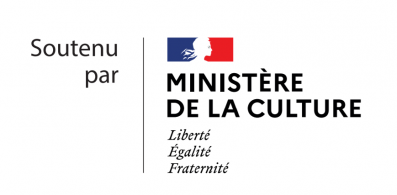
Ministry of Culture
The French Ministry of Culture aims to make the major works of humanity— and especially those of France— accessible to the largest number of people possible. As such, it maintains a policy of conservation, of protection, and of development of all components of French cultural heritage. It promotes the creation of works of art and of the mind, and the development of art practices and education. It further contributes to cultural initiatives outside of France, and to initiatives relating to the establishment of French cultural programs throughout the world.
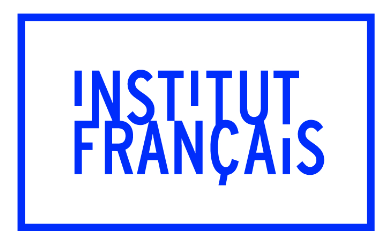
Institut français
The Institut français is responsible for France’s international cultural program. Supervised by both the Ministry for Europe and Foreign Affairs and by the Ministry of Culture, it promotes French culture abroad through cultural exchange initiatives. Operating in a space where the arts, intellectual exchange, cultural and social innovation, and linguistic partnerships interact and intersect, it is also responsible for promoting the French language and the sharing of works, artists, and ideas all over the world. The Institut français is one of Villa Albertine’s main French partners.
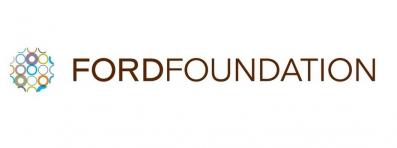
Ford Foundation
The Ford Foundation is an independent organization working to address inequality and build a future grounded in justice. For more than 85 years, it has supported visionaries on the frontlines of social change worldwide, guided by its mission to strengthen democratic values, reduce poverty and injustice, promote international cooperation, and advance human achievement. Today, with an endowment of $16 billion, the foundation has headquarters in New York and 10 regional offices across Africa, Asia, Latin America, and the Middle East.
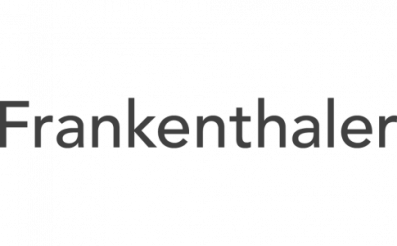
Helen Frankenthaler Foundation
The Helen Frankenthaler Foundation, established and endowed by the artist during her lifetime (1928-2011), is dedicated to promoting greater public interest in and understanding of the visual arts. It supports the artist’s legacy through a variety of initiatives, including exhibitions, loans of artworks, research and publications, conservation, grants, and educational programs for the public and the scholarly community. As the principal beneficiary of Helen Frankenthaler’s estate, the Foundation maintains an archive of original papers and materials pertaining to her life and work and a collection of her artwork in a variety of media.
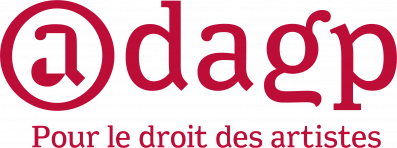
ADAGP
Founded by artists in 1953, the ADAGP represents 240,000 authors worldwide, in all disciplines of visual art, including painting, sculpture, photography, design, graphic novels, street art, video art, digital art, architecture and more… At the heart of an international network of 55 partner organisations, the ADAGP collects and distributes royalties, protects artists and fights to improve authors’ rights. Today, it is the world’s top society of authors in the visual arts. Eager to place creativity at the heart of the world, the ADAGP encourages the creative scene by initiating and/or financially supporting projects to highlight visual arts and promote them on a national and international scale.

